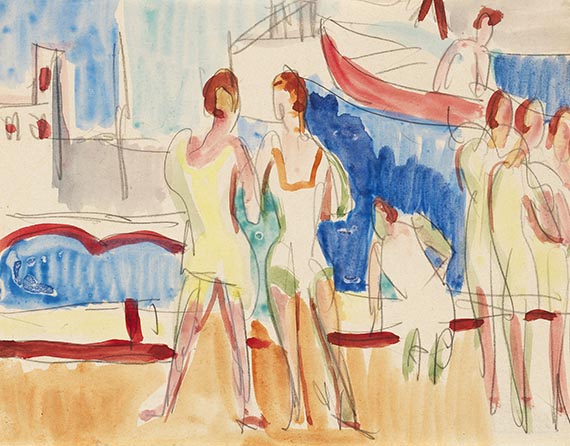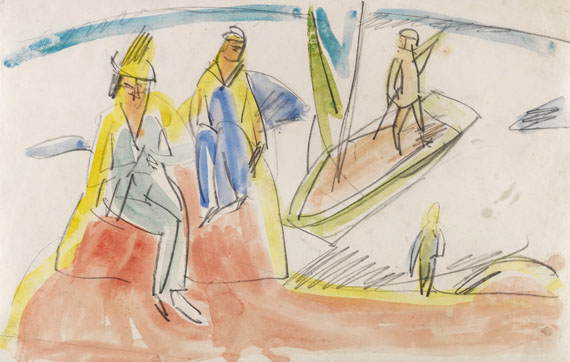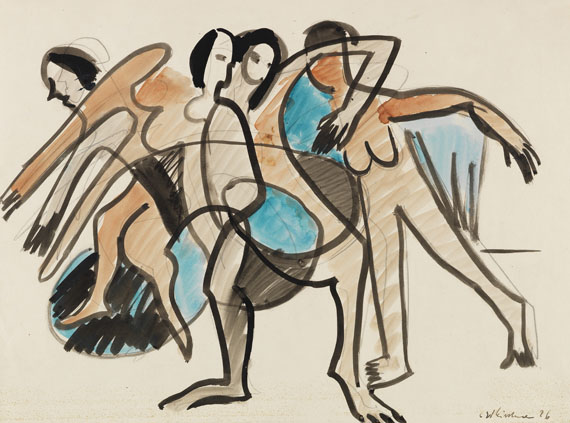428
Ernst Ludwig Kirchner
Sportler im Segelhafen, Um 1928.
WatercolorWatercolor and pencil
Stima: € 15,000 / $ 16,050
Sportler im Segelhafen. Um 1928.
WatercolorWatercolor and pencil.
With the estate stamp of the Kunstmuseums Basel (Lugt 1570 b) and the hand-written registration number "St. 157" on the reverse. On wove paper. 16 x 20.8 cm (6.2 x 8.1 in), the full sheet. [CH].
• Elaborate watercolorfrom the Davos days.
• The closely related painting "Ruderer" (Gordon 916) was created around the same time.
• Even during Kirchner's time in Dresden and Berlin, human physiognomy, posture and a wide variety of motion sequences were at the heart of his work.
• In addition to his great fascination with dance, the pictorial motif of other sporting activities plays a major role in Kirchner's oeuvre.
This work is documented in the Ernst Ludwig Kirchner Archive, Wichtrach/Bern.
PROVENANCE: Artist's estate (Davos 1938, Kunstmuseum Basel 1946).
Galerie Wolfgang Ketterer, Munich (1968).
Hermann Gerlinger Collection, Würzburg (with the collector's stamp Lugt 6032).
EXHIBITION: Schleswig-Holsteinisches Landesmuseum, Schloss Gottorf, Schleswig (permanent loan from the Hermann Gerlinger Collection, 1995-2001).
Kunstmuseum Moritzburg, Halle an der Saale (permanent loan from the Hermann Gerlinger Collection, 2001-2017).
Buchheim Museum, Bernried (permanent loan from the Hermann Gerlinger Collection, 2017-2022).
LITERATURE: Galerie Wolfgang Ketterer, inventory catalog no. 45, Munich 1968, no. 938 (black-and-white illu.).
Galerie Wolfgang Ketterer, inventory catalog no. 51, Munich 1968/69, cat. no. 1325 (black-and-white illu).
Heinz Spielmann (ed.), Die Maler der Brücke. Sammlung Hermann Gerlinger, Stuttgart 1995, p. 279, SHG no. 410 (illu.).
Hermann Gerlinger, Katja Schneider (eds.), Die Maler der Brücke. Inventory catalog Hermann Gerlinger Collection, Halle (Saale) 2005, p. 360, SHG no. 800 (illu.).
Called up: June 8, 2024 - ca. 17.37 h +/- 20 min.
WatercolorWatercolor and pencil.
With the estate stamp of the Kunstmuseums Basel (Lugt 1570 b) and the hand-written registration number "St. 157" on the reverse. On wove paper. 16 x 20.8 cm (6.2 x 8.1 in), the full sheet. [CH].
• Elaborate watercolorfrom the Davos days.
• The closely related painting "Ruderer" (Gordon 916) was created around the same time.
• Even during Kirchner's time in Dresden and Berlin, human physiognomy, posture and a wide variety of motion sequences were at the heart of his work.
• In addition to his great fascination with dance, the pictorial motif of other sporting activities plays a major role in Kirchner's oeuvre.
This work is documented in the Ernst Ludwig Kirchner Archive, Wichtrach/Bern.
PROVENANCE: Artist's estate (Davos 1938, Kunstmuseum Basel 1946).
Galerie Wolfgang Ketterer, Munich (1968).
Hermann Gerlinger Collection, Würzburg (with the collector's stamp Lugt 6032).
EXHIBITION: Schleswig-Holsteinisches Landesmuseum, Schloss Gottorf, Schleswig (permanent loan from the Hermann Gerlinger Collection, 1995-2001).
Kunstmuseum Moritzburg, Halle an der Saale (permanent loan from the Hermann Gerlinger Collection, 2001-2017).
Buchheim Museum, Bernried (permanent loan from the Hermann Gerlinger Collection, 2017-2022).
LITERATURE: Galerie Wolfgang Ketterer, inventory catalog no. 45, Munich 1968, no. 938 (black-and-white illu.).
Galerie Wolfgang Ketterer, inventory catalog no. 51, Munich 1968/69, cat. no. 1325 (black-and-white illu).
Heinz Spielmann (ed.), Die Maler der Brücke. Sammlung Hermann Gerlinger, Stuttgart 1995, p. 279, SHG no. 410 (illu.).
Hermann Gerlinger, Katja Schneider (eds.), Die Maler der Brücke. Inventory catalog Hermann Gerlinger Collection, Halle (Saale) 2005, p. 360, SHG no. 800 (illu.).
Called up: June 8, 2024 - ca. 17.37 h +/- 20 min.
Even during Kirchner's time in Dresden and Berlin, human physiognomy, posture and a wide variety of movements were at the heart of his work. With great observational skills, the artist captured the anatomy and fleeting or complex movements of his models in just a few dynamic lines on paper, canvas and printing blocks. Throughout his life, Kirchner had an enormous fascination for dance, but the artist also pursued his early interest in movement and the human body by depicting other sporting activities. Kirchner's motifs include archery, equestrian sports, motorcycling and ski jumping (Kirchner Museum, Davos), racing and cycling (Städel Museum, Frankfurt am Main), ice skating (Hessisches Landesmuseum, Darmstadt), ice hockey (Staatsgalerie Stuttgart), acrobats on the trapeze, broad-shouldered wrestlers (Cleveland Museum of Art, etc.) and rowers.
The present watercolor from the late 1920s already shows a similar, albeit independent composition as the painting "Ruderer" (1928/29, Gordon 916), which was created at almost the same time. The male figures placed in front of a river landscape with a bridge wear sportswear typical of rowers, however, they are arranged in different groups as in the painting. The boat occupied by only one person, which will eventually fill the entire upper half of the pictorial surface in the painting, and an athlete with a stooped posture who is about to take up his oar, are already clearly worked out. Kirchner captured the architecture, the boat and especially the dynamic, powerful bodies of the rowers with a few characteristic brushstrokes before painting the scenery in a variety of colors. It was at this time that Kirchner began to treat the form in a completely two-dimensional way for the first time. Kirchner solved the problem of depicting depth and the distance between foreground and background in the surface: the river and the rowing boat are placed in the foreground in the top right corner in the same size as the figures. This marks the beginning of a completely new stylistic development in Kirchner's artistic work. [CH]
The present watercolor from the late 1920s already shows a similar, albeit independent composition as the painting "Ruderer" (1928/29, Gordon 916), which was created at almost the same time. The male figures placed in front of a river landscape with a bridge wear sportswear typical of rowers, however, they are arranged in different groups as in the painting. The boat occupied by only one person, which will eventually fill the entire upper half of the pictorial surface in the painting, and an athlete with a stooped posture who is about to take up his oar, are already clearly worked out. Kirchner captured the architecture, the boat and especially the dynamic, powerful bodies of the rowers with a few characteristic brushstrokes before painting the scenery in a variety of colors. It was at this time that Kirchner began to treat the form in a completely two-dimensional way for the first time. Kirchner solved the problem of depicting depth and the distance between foreground and background in the surface: the river and the rowing boat are placed in the foreground in the top right corner in the same size as the figures. This marks the beginning of a completely new stylistic development in Kirchner's artistic work. [CH]
428
Ernst Ludwig Kirchner
Sportler im Segelhafen, Um 1928.
WatercolorWatercolor and pencil
Stima: € 15,000 / $ 16,050
Commissione, tassa e diritti di seguito
Quest'oggetto viene offerto con regime fiscale normale o con imposizione sul margine di profitto.
Calcolo commissione particolare sul margine del profitto:
Prezzo di aggiudicazione fino a 800.000 €: supplemento del 32%
Prezzo di aggiudicazione superiore a 800.000 €: Parte del prezzo fino a 800.000 € supplemento del 32 %, parte del prezzo che supera i 800.000 € supplemento del 27%
Prezzo di aggiudicazione superiore a 4.000.000 €: Parte del prezzo che supera i 4.000.000 € supplemento del 22%
Nel supplemento è compresa l'IVA che tuttavia non compare sulla fattura.
Calcolo regime fiscale normale:
Prezzo di aggiudicazione fino a 800.000 €: supplemento del 27%, più l´IVA legale
Prezzo di aggiudicazione superiore a 800.000 €: Parte del prezzo fino a 800.000 € supplemento del 27 %, parte del prezzo che supera i 800.000 € supplemento del 21%, a talvolta maggiorato dell'IVA legale.
Prezzo di aggiudicazione superiore a 4.000.000 €: Parte del prezzo che supera i 4.000.000 € supplemento del 15%, a talvolta maggiorato dell'IVA legale.
La preghiamo di avvisarci prima della fatturazione nel caso in cui desidera applicare il regime fiscale normale.
Calcolo diritti di seguito:
Per gli oggetti realizzati da un artista la cui morte risale a meno di 70 anni, viene fatturata una quota sui diritti di seguito pari all'4% IVA legale inclusa.
Calcolo commissione particolare sul margine del profitto:
Prezzo di aggiudicazione fino a 800.000 €: supplemento del 32%
Prezzo di aggiudicazione superiore a 800.000 €: Parte del prezzo fino a 800.000 € supplemento del 32 %, parte del prezzo che supera i 800.000 € supplemento del 27%
Prezzo di aggiudicazione superiore a 4.000.000 €: Parte del prezzo che supera i 4.000.000 € supplemento del 22%
Nel supplemento è compresa l'IVA che tuttavia non compare sulla fattura.
Calcolo regime fiscale normale:
Prezzo di aggiudicazione fino a 800.000 €: supplemento del 27%, più l´IVA legale
Prezzo di aggiudicazione superiore a 800.000 €: Parte del prezzo fino a 800.000 € supplemento del 27 %, parte del prezzo che supera i 800.000 € supplemento del 21%, a talvolta maggiorato dell'IVA legale.
Prezzo di aggiudicazione superiore a 4.000.000 €: Parte del prezzo che supera i 4.000.000 € supplemento del 15%, a talvolta maggiorato dell'IVA legale.
La preghiamo di avvisarci prima della fatturazione nel caso in cui desidera applicare il regime fiscale normale.
Calcolo diritti di seguito:
Per gli oggetti realizzati da un artista la cui morte risale a meno di 70 anni, viene fatturata una quota sui diritti di seguito pari all'4% IVA legale inclusa.




 Lot 428
Lot 428 

